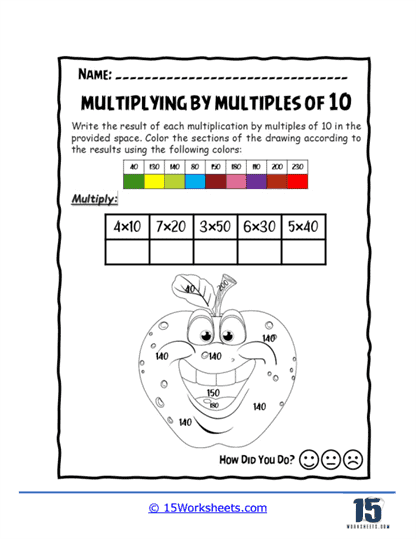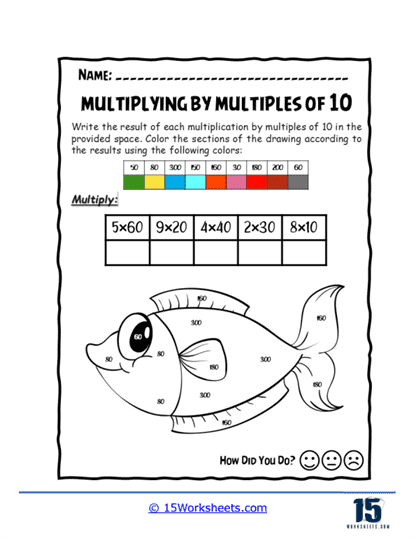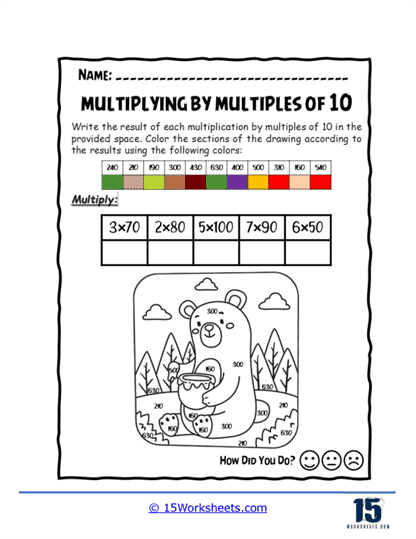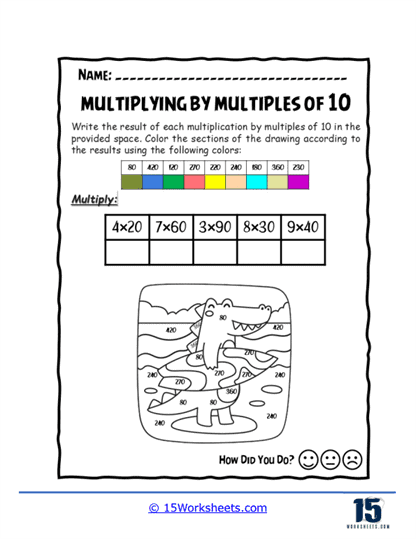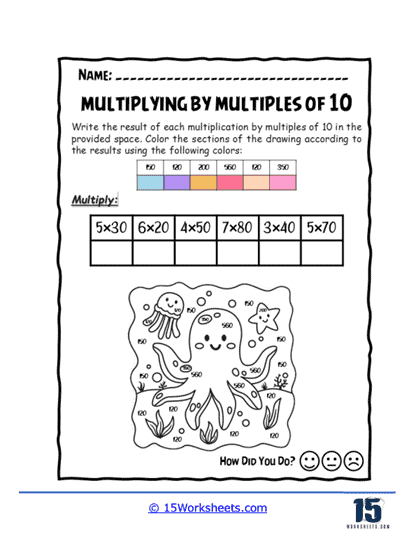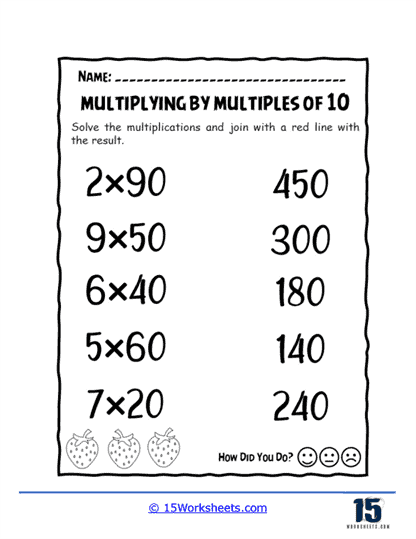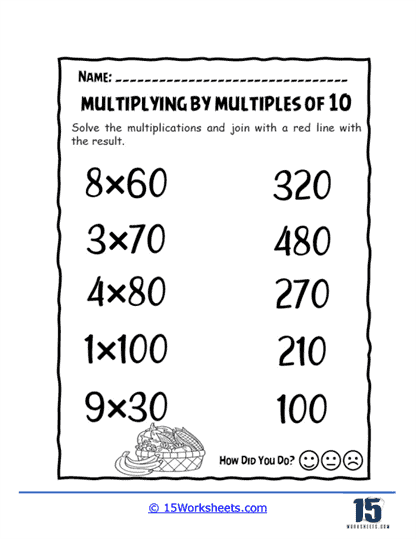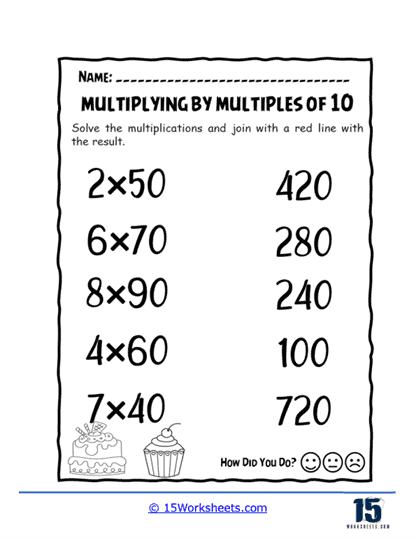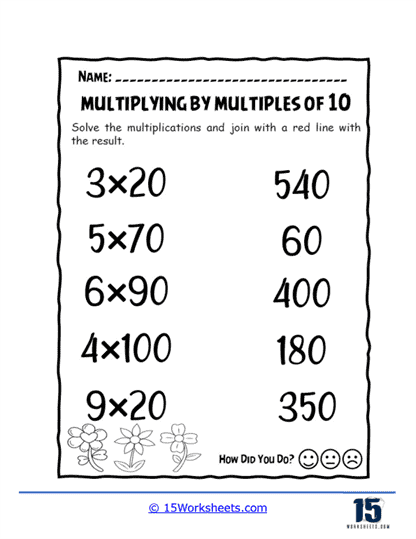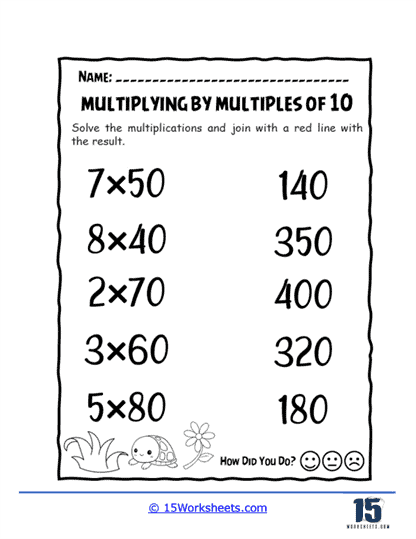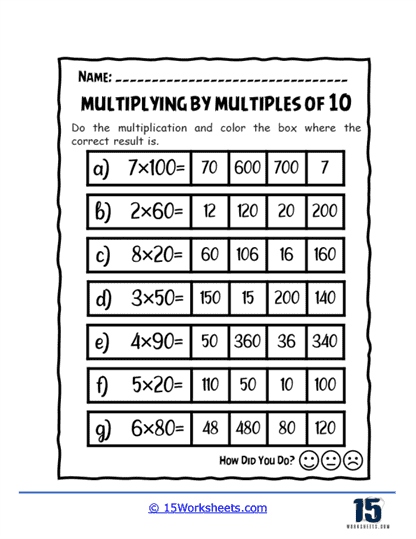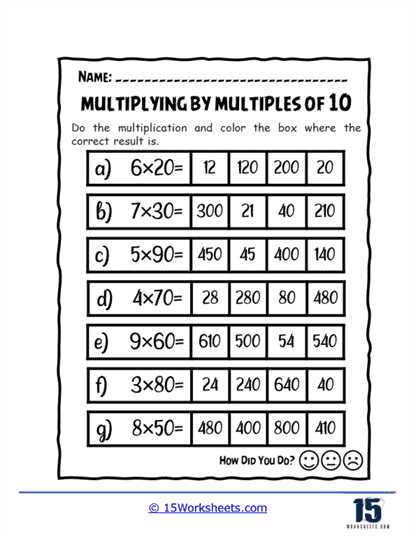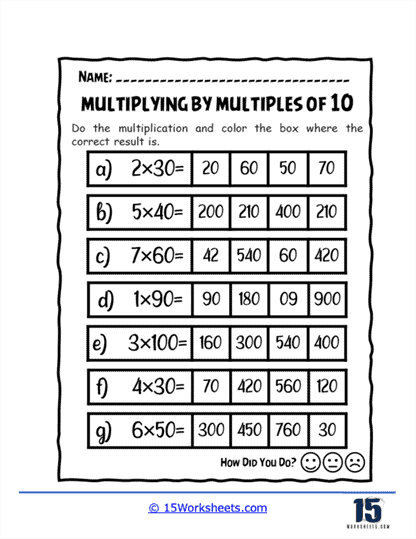Multiplying by 10s Worksheets
About These 15 Worksheets
These worksheets can help students grasp the fundamental concept of multiplication, particularly when it involves multiplying by multiples of ten, such as 10, 20, 30, and so on. These worksheets are an essential part of early math education because they build a strong foundation for understanding how numbers work, especially in the context of place value and the patterns that emerge in multiplication. Mastery of these concepts not only helps students become more confident in basic math but also sets the stage for their future success in more advanced math topics like algebra.
When students work on these worksheets, they encounter a variety of exercises that gradually increase in complexity, helping them to solidify their understanding of the multiplication process. The simplest form of these worksheets might include basic problems where students are asked to multiply single-digit numbers by 10. For example, they might solve problems like 4 x 10, 7 x 10, or 9 x 10. These straightforward problems help students recognize the pattern that when you multiply any number by 10, you essentially add a zero to the end of that number. This is a crucial insight because it ties directly into the concept of place value, which is foundational in math.
As students become more comfortable with multiplying by 10, the worksheets might introduce problems that involve multiplying by larger multiples of ten, such as 20, 30, 40, and so on. Here, students start to see that the pattern they observed with 10 continues – multiplying by 20 is like multiplying by 2 and then adding a zero, multiplying by 30 is like multiplying by 3 and adding a zero, and so forth. These exercises not only reinforce the concept of place value but also help students begin to understand the distributive property of multiplication, which states that a number multiplied by a sum is equal to the sum of that number multiplied by each addend separately. For example, they start to see that 3 x 20 is the same as 3 x (2 x 10), or 60.
This collection of worksheets includes more challenging exercises that require students to use their multiplication skills in conjunction with other math operations. For example, a worksheet might ask students to solve problems like (4 x 10) + 30 or 50 – (2 x 10). These types of problems are crucial because they help students understand how multiplication interacts with addition, subtraction, and even division. This understanding is critical as they move into more advanced math, where they will need to solve multi-step problems and equations.
Some worksheets incorporate activities that encourage students to explore the patterns that arise when multiplying by 10s. For example, a worksheet might present a series of numbers and ask students to identify the pattern when each number is multiplied by 10, 20, 30, etc. This not only reinforces their multiplication skills but also helps them develop a deeper understanding of number sense and the relationships between numbers. Recognizing these patterns is a key skill in algebra, where students will need to identify and work with patterns and sequences to solve equations and understand functions.
Some of the worksheets were designed to help students practice multiplying by multiples of 10 while integrating a fun, color-by-number activity to reinforce their learning. Students are required to solve a series of multiplication problems, each involving a base number multiplied by a multiple of 10 (e.g., 5 x 60, 9 x 20). Once the students have calculated the products, they use a color key provided at the top of the worksheet to color sections of a fish drawing according to the results. This not only reinforces the multiplication skills but also helps students connect math with a creative activity, making learning more engaging and enjoyable.
This series of worksheets aims to teach students how to efficiently multiply numbers by multiples of 10, emphasizing the pattern of place value in multiplication. By engaging in this activity, students reinforce their understanding that multiplying by 10, 20, or any other multiple of 10 simply shifts the number’s digits to the left, making it easier to solve the problem mentally. Additionally, the color-coding aspect adds an element of self-checking, as students will need to ensure their answers match the correct color to complete the picture accurately. This combination of math practice with a creative task helps solidify multiplication skills while making the learning experience enjoyable and memorable.
One of the most beneficial aspects of these worksheets is how they lay the groundwork for understanding algebraic concepts. Algebra is often a challenging subject for students because it requires them to think abstractly about numbers and operations. However, if students have a strong grasp of basic multiplication and place value, they will find it easier to understand algebraic concepts like variables, coefficients, and equations.
For example, when students learn that multiplying by 10 simply shifts the digits one place to the left, they are actually building an understanding of base-10, which is essential in algebra. In algebra, students often work with powers of ten, and understanding how multiplying by 10 affects a number’s place value helps them grasp these more complex ideas. Furthermore, the distributive property, which students begin to understand through multiplying by 10s, is a key concept in algebra. When students later encounter expressions like 2(x + 5), they will already have some experience with breaking down and simplifying such expressions thanks to the foundational work they did on these worksheets.
Another critical skill that these worksheets help develop is mental math. As students practice multiplying by 10, they start to do these calculations more quickly and with greater confidence. This mental agility is essential in algebra, where students often need to manipulate and simplify expressions without always resorting to paper and pencil. Being able to quickly multiply by 10s and recognize the resulting patterns helps students approach algebraic problems with more confidence and efficiency.
Another important skill that is reinforced by these worksheets is the ability to estimate. When students multiply by 10s, they quickly learn to estimate the size of the result. For example, they know that 7 x 10 will give them something in the tens, while 7 x 100 will give them something in the hundreds. This skill is essential in algebra and higher-level math, where students often need to make quick estimates to check the reasonableness of their answers. Estimation also plays a role in understanding limits, a concept that will come up in calculus, where students need to estimate the behavior of functions as they approach a certain point.

